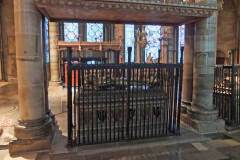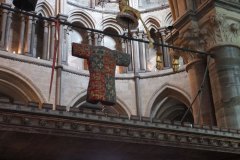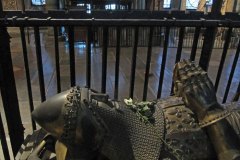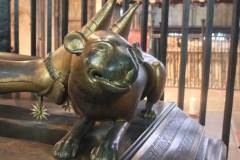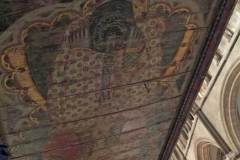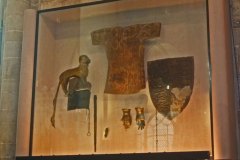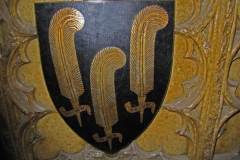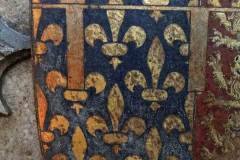During his life Edward was known as Edward of Woodstock – he was known as the Black Prince only from the 16th century onwards. Experts have not agreed on the reason why. The notion that he wore black armour has not been substantiated. Some point to his black shield, others to the ‘black’ or evil events in the massacre of Limoges in 1370 and the fear this instilled in adversaries. Edward was the eldest son of Edward III. He enjoyed popular acclaim at a young age through his military success over the French at key battles of the Hundred Years War – particularly at Crecy (1346) and Poitiers (1356). He was only 45 when he died, in London, too early to become king as his father survived him. His illness has been described variously as dysentery, cancer or multiple sclerosis. Edward’s tomb, hailed as one of the finest in medieval England, closely follows instructions left in his will. Only the location of the tomb was changed – Edward directed he should be buried in the crypt near the chapel of Our Lady Undercroft but was in fact placed close to Becket’s shrine. The base of the tomb is of Purbeck marble, the effigy of latten overgilt (a form of medieval brass), and the painted tester, with its image of the Trinity, above in wood. According to Collinson (1995), the tomb ‘can fairly be attributed to Henry Yevele’.
Edward’s heraldic ‘achievements’ (shield, helm and crest, jupon, scabbard and gauntlets) are now on display in the crypt, but modern copies (1950s) of these appear above his tomb. The jupon (close fitting tunic) is the only surviving English example of the period. The shield is of poplar wood, glued with layers of linen, and bearing heraldic charges of boiled leather. The huge iron helm is cylindrical with a flat top, eye holes and breathing holes. It has no visor, and was intended only for jousting. The helm is surmounted by a crest, consisting of a lion standing upon a cap of maintenance (with lion hair represented in plaster), both made from leather. The hat is lined with red velvet. The scabbard and belt have survived, but not the sword. The gauntlets are of copper gilt and are lined with soft doeskin. Most of these items are associated more with jousting that with warfare.
The three ostrich feathers and motto ‘Ich dien’ (I serve) survive to this day as emblem and motto of the Prince of Wales. The fleur de lys, denoting the claims of Edward III to the French crown, appears on alternate shields around the tomb. If you examine the kerb stones of the aisle immediately opposite the tomb, you’ll notice these are very worn and irregular – thought to indicate the existence of a small Black Prince’s chantry in the past.
What to see:
- one of the finest medieval tombs in England, with copies of Edward’s ‘achievements’ displayed above
- effigy in latten overgilt (medieval brass) showing Edward at prayer – his helmet has lost its precious stones; his moustache sits neatly outside his face mail; writers disagree over the odd animal at his feet but it is generally described it as a French bull dog; the effigy looked black before layers of lacquer were cleaned off during major restoration in the 1930s
- painted tester with depiction of The Trinity
- original achievements in protective glass case nearby
- repeated depiction of ostrich feathers and fleur de lys on the tomb side
Sources; see standard sources; also Canterbury Cathedral Chronicle 1954 (article by James Mann); Country Life 21 September 1935 The Black Prince’s tomb by E W Tristram
NOTE: for Cathedral Podcast on the Black Prince click here

